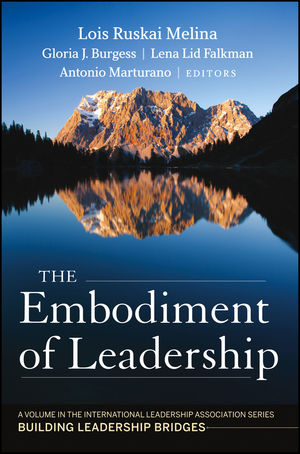 Lois Ruskadai Melina, Gloria J. Burgess, Lena Lid Falkman, and Antonio Marturano, eds. The Embodiment of Leadership:A Volume in the International Leadership Association Series, Building Leadership Bridges. San Francisco: Jossey-Bass, 2013.
Lois Ruskadai Melina, Gloria J. Burgess, Lena Lid Falkman, and Antonio Marturano, eds. The Embodiment of Leadership:A Volume in the International Leadership Association Series, Building Leadership Bridges. San Francisco: Jossey-Bass, 2013.
One of the Editors, Antonio Marturano, is the Integral Leadership Review Associate Editor and Bureau Chief for Italy. He also guest edited the special issue on Italy in the January 2013 issue of ILR. Here he joins with International Leadership Association colleagues to address an issue that has received some attention in the pages of ILR: The Embodiment of Leadership.
The book is divided into three parts with four chapters by different authors per part. The sections are entitled:
- Leadership Thresholds,
- Leaders Are Their Bodies, and
- Leadership By and Through the Body,
and each includes an introduction by one of the editors. Chapter topics include Dramatic Leadership, Michelle Obama’s Embodied Authentic Leadership, and Embodied Learning Experience in Leadership Development.
I took an unusual approach (for me) in approaching this book: I looked at the citations and references for each chapter. I found
- The usual references to leadership theory stars – Avolio, George, Heifitz, Kellerman, Kouzes, for example;
- Multiple references to “newcomers” like Donna Ladkin, Wendelin Kupers, etc.;
- Multiple references to the emotional intelligence crowd, particularly Boyatzix, McKee and Goleman;
- Numerous references to Foucault and Gadamer and Merleau-Ponty which affirms the postmodern hermeneutic training found in contemporary graduate education;
- References to adult development theorists, e.g. Cook-Greuter, Kegan, Gilligan, Torbert; and
- Several references to works published in Integral Leadership Review!
All of this suggests that this is a book worth reading for the freshness of perspective it embodies.
Melina notes, “This volume presents not only some of the ways to conceptualize the relationship between leadership and the body, but some of the ways to take on the challenge of articulating and translating the embodied knowledge of leadership.” Here is a set of works that emphasize the importance of “an integrated mind-body approach” as well as an acknowledgement in some of the works of a more holistic, integral view of leadership dynamics. I appreciated Melina’s reference to the idea of sense-making ”by leaders as something produced through an intellectual analysis of observed and experienced data, arguing instead that meaning is received through the senses, creating what we know as our experience.” By implication, such sense-making does not involve just monological processes internal to the individual, but dialogical exchanges between and among individuals and context mediated by, among other things, the senses.
Marturano comments that this work focuses on leadership, not just leaders. Holding this understanding builds on the work of David V. Day, Donna Ladkin and others in drawing this distinction. By doing so we begin to frame the field in ways that allow us to enrich leader and leadership development, practice and study. We turn away from the conflation of terms that is so characteristic of the history of this field. This is particularly noteworthy in the work of Salovaara and Ropo’s consideration of the language used by leadership development participants. They note four important shifts, as outlined by Marturnao are:
- From leader-centricity toward leadership,
- From content to process orientation,
- From generic input to tailor-made processes, and
- From an intellectual-rational approach to an embodied one.
The first is an acknowledgement that we are working with a social phenomenon that includes individuals and collectives and moves us away from universal characteristics and competencies for leaders.
Here is a set of interesting fresh perspectives drawing on a range of theory and models that traditional leadership academics and gurus rarely consider in the literature.
